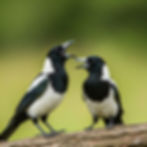Shobha Srinivasan
Children's Book Author

Australian songbirds and their evolution
Jan 12
3 min read
7
60
12

Australia boasts a diverse array of melodious songbirds, all members of the Passeriformes order. Characterized by their unique perching abilities and intricate vocalizations, this order encompasses a wide range of species - Some of these songbirds are Magpies, Wrens, Treecreepers, Pardalotes, Honeyeaters, Robins, Whistlers, Magpies, Grass finches, Rosellas, Currawongs and Butcherbirds.
Songbirds, also known as passerines, are a diverse group comprising over 6,000 species worldwide. Remarkably, they represent roughly half of all bird species on Earth. These social creatures often live in family groups, engaging in collective activities such as resting, foraging, and raising their young. This harmonious and cooperative lifestyle offers valuable lessons for human societies.
Cooperative breeding, where songbirds receive assistance from helpers (typically older siblings) in raising their young, is prevalent in Australia, with 22% of species engaging in this behaviour. This cooperative breeding strategy is less common globally, occurring in only 3% of songbird species worldwide.
Australian songbirds possess remarkable vocal abilities. They can produce hundreds of distinct songs, each intricate with dozens of notes per second. This vocal dexterity is facilitated by sophisticated vocal anatomy, involving precise coordination of various muscles to generate a wide range of sounds. Equipped with a unique vocal organ called a syrinx, songbirds exhibit remarkable mastery over their vocal muscles, allowing them to create a stunning array of sounds.
Baby songbirds acquire their songs by learning from adult birds, a process known as vocal learning. Initially, young birds produce a series of random notes. Through practice and refinement, they gradually shape these sounds into the specific song characteristic of their species.
Fairy wrens sing to their unhatched eggs to teach their babies a password, a single note, that the babies use later to beg for food.

Magpies are known for their continuous learning. Throughout their lives, they acquire and incorporate new songs into their repertoire. In contrast, finches have a limited window for song learning, typically during their early development.
The striking parallels between birdsong and human speech have led neuroscientists to utilize bird models to investigate the development of human speech.
The earliest songbirds originated in Australia approximately 24 million years ago and the earliest ancient songbirds embarked on a remarkable journey of diversification. As sea levels receded, land bridges emerged, facilitating the movement of these birds and other animals into Asia, Europe, and New Guinea. After millions of years of evolutionary adaptation, some of these lineages even returned to Australia. Remarkably, all of the world's songbirds can trace their ancestry back to this Australian origin, a conclusion strongly supported by genetic and DNA analyses. (Australian Museum)
The catastrophic asteroid impact 66 million years ago, which wiped out 75% of life on Earth, severely impacted avian and other species. However, Australia, then part of the ancient supercontinent East Gondwana, served as a refuge, acting as a 'Noah's Ark' for many creatures, including the ancestors of modern songbirds. This region proved to be one of the safest havens during this mass extinction event.
When the dust settled and life began to recover, these ancestral songbirds flourished in Australia. Remarkably, East Gondwana was the sole region on the planet where these lineages survived, making Australia the cradle of modern songbird evolution.
In the 1700s, academia and scientists widely believed that birds originated in the Northern Hemisphere and subsequently migrated to Australia, which was then considered an evolutionary 'dead end'. However, evidence suggests the opposite: songbirds likely first evolved in Australia and gradually dispersed northward over millions of years.
So, there you have it – songbirds - Australian and otherwise - are just amazing! Next time you hear a bird singing, think about all the millions of years it took for them to get that good. It's like a living history lesson!
Information acquired from the Australian Museum and The Murgon Fossil Museum and Fine Art Gallery






Shobha, what interesting information you have gleaned about our songbirds and so beautifully written.
I can see your your life as a published writer has only just begun.
I’ll keep reading.
Never knew the about the Aussie connection to song birds. Learn something new every day. Nice write up.
Good info. Wasn't aware of this!
Wow I never knew all birds originated from Australia.
A great read Shobha.
Great read :)
6000 species of passerines worldwide! Fairy wrens singing to their unhatched eggs (a password!), and much more. What a wonderful vignette about these amazing songbirds Thanks Shobha Srinivasan